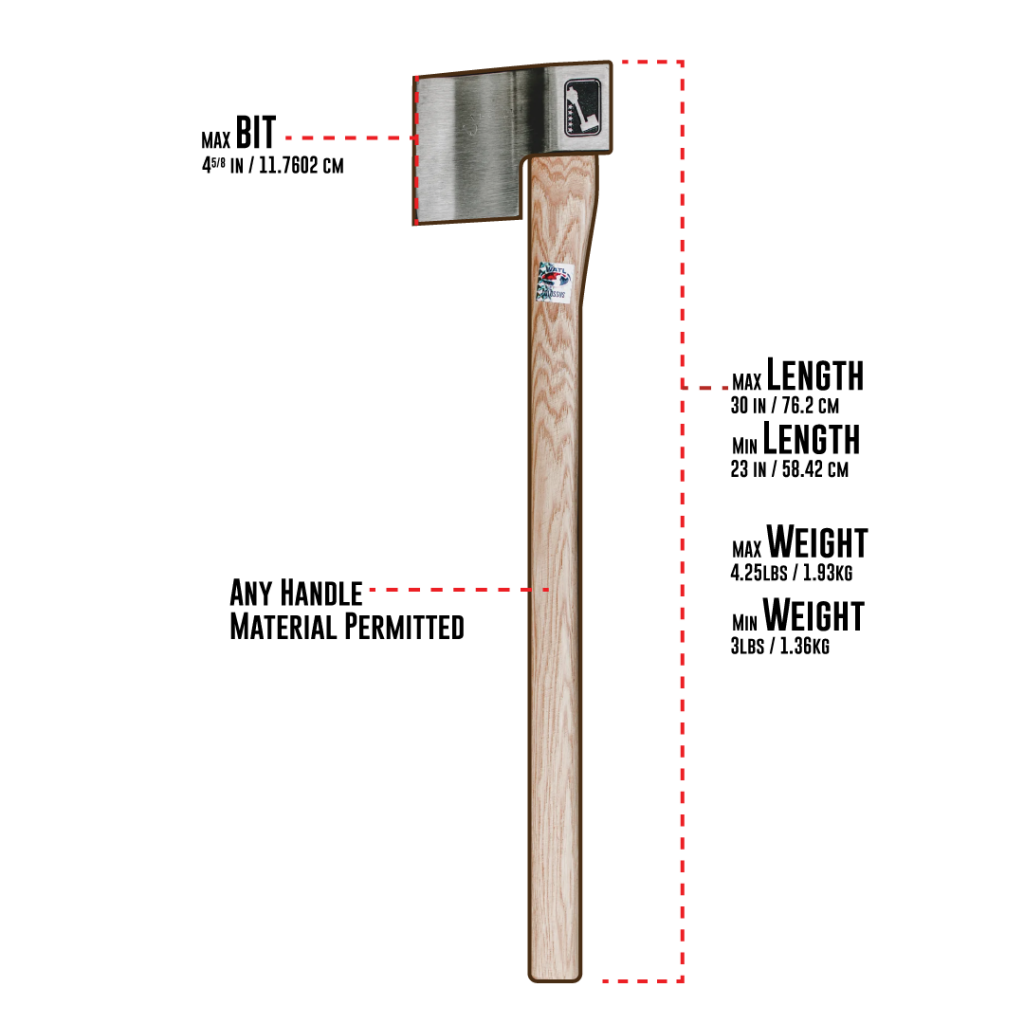Gameplay Rules
It is the duty of the Head Judge at any sanctioned event to interpret and apply the rules as fairly and consistently as possible. All decisions made at the discretion of the Head Judge, in the interest of fair play, may overrule the below in cases in which it is deemed necessary to the fair application of the rules as intended. Abuse of this discretion or disagreements about the decisions of the Head Judge may be reported or appealed to the WATL® Commissioner, or the WATL® Head of Officiating.
Upcoming Rules Notice
This ruleset is upcoming and is not currently in practice until 2026.
Click below to view the 2025 Gameplay Rules. Please note, the 2025 ruleset is no longer active or valid as of 12/31/25 with the exception of the World Axe Throwing Championship in April 2026.
Section A: Specifications
1. Axe Regulations
- The maximum specifications for all hatchets are:
- Weight – 3lbs/1.36kg total
- Length – 19in/48.26cm (as measured from the top of the eye)
- Bit – 4in/10.16cm (as measured toe to heel in a straight line)
- Axes may only have one sharp bit. No sharpened bits, spikes, or blades are allowed on the poll of the axe.
- Axe Heads must be held securely to the handle. Axe heads that are in danger of coming off the handle or have a head that is easily removed (ie. heads that are clamped or held into the handle by a screw or pin) are not legal for sanctioned events unless otherwise approved by WATL®.
- Illegal Axes for Competition
- Any axe that infringes on design patents and trademarks held by any organization or is a direct copy or replica of other individuals’ or businesses’ intellectual property, unless special dispensation has been granted
- Warriors, Hacha Manufacturing, Mirror Edge and Urban Edge axes
- Use of illegal axes may result in the loss of points, position and/or prize money. At WATL’s® discretion, further action may be taken.
2. Judging
- Competitors and spectators will not bully, harass, or attempt to influence a judge in any non-constructive manner. Any person found to be doing so will receive a Code of Conduct violation.
- Certified Judge Requirements
- At least 1 Certified Judge must be present for every 16 competitors at all WATL-sanctioned leagues, Regional and Local tournaments.
- National tournaments require 1 Certified Judge per lane in use.
- Certified Judges must be actively working sanctioned events to count towards the Judge requirement minimums. Participating competitors who are Certified Judges, but are not actively working the event, are not counted towards this minimum requirement.
- Certified Judges are allowed to participate as competitors but may never score their own sanctioned games.
- Certified Judges should not be, or become, impaired (by alcohol or any other mind-altering substance) during any time they may reasonably be expected to score at sanctioned events. If it is suspected that a Certified Judge is, or has become impaired in such a way, then they must be removed from judging immediately and may be subject to removal of their certification.
- Certified Judges should not preside over sanctioned games where a significant conflict of interest exists, such as close personal relationships (e.g., family members, significant others) unless the circumstances are unavoidable. In such cases, Certified Judges must exercise the highest standards of impartiality and disclose greater potential conflicts whenever possible.
- Certified Judges are responsible for disclosing any conflicts of interest to competitors before a sanctioned game.
- Competitors can request another Certified Judge if a conflict of interest is present.
- Any incorrect applications of rules made in situations where bias may be present could lead to the revocation of certification.
- If another Certified Judge or competitor believes that a Certified Judge is not following the current rules and regulations or is making incorrect calls, they must report it directly to a Head Judge or other event authority immediately.
- Certified Judges may be pulled from scoring at any time by any event or WATL® authority.
- Any gross misconduct from Certified Judges must be reported to [email protected].
3. Lanes
- Each throwing area is designated as a throwing lane.
- A regulation lane for competition must contain 2 targets.
- Fences or walls typically block this area from the rest of the facility to keep competitors and axes contained in a safe environment.
- Only the participating competitors and a Certified Judge are allowed inside the bounds of a lane during a match. This includes ensuring the area is clear behind both the competitors and the targets, if applicable.
4. Target Specifications
- Each WATL-sanctioned event or league should have targets drawn with a WATL official target stencil.
- Targets at all sanctioned leagues and events must adhere to the measurements specified in this section.
- A placement allowance of up to ½in to account for measurement variabilities (tape measure inconsistencies, board width imperfections, etc) is acceptable provided that uniformity is maintained across targets within the same event.
- Variances in scoring zone locations, while allowed, should also fall within ¾in of all corresponding targets within the lane.
- A placement allowance of up to ½in to account for measurement variabilities (tape measure inconsistencies, board width imperfections, etc) is acceptable provided that uniformity is maintained across targets within the same event.
- Scoring zone sizes should all conform to what is written below with the understanding that some reasonable expansion may occur as targets deteriorate.
- The target’s center is 60in from the ground, positioned at the halfway point of the middle vertical board.
- A black marker will be used to draw the target lines.
- Lines should all be 20mm thick, with a ⅛in allowance to account for bleed and marker variability.
- The middle bullseye is 1.5in in diameter, centered in the target, outlined with a black ballpoint pen, and colored in red.
- In all National tournaments, the inner edge of the center 5 ring must also be outlined with a red ballpoint pen, which will count as part of the scoring zone.
- Pen lines will be drawn with the use of a centering tool such as the official WATL Perfect 6.
- The 4 outer bullseyes and 5 rings are centered within the 3 ring of the target.
- The outer 5 rings are 3.5in in diameter, and the outer bullseyes are 1.5in in diameter, centered within each of the outer 5 rings.
- The lower outer 5 rings should measure 56.5in on center from the ground.
- The upper outer 5 rings should measure 63.5in on center from the ground.
- The outer 5 rings and outer bullseyes must be drawn with a black ballpoint pen, and either the outer 5 or the outer bullseyes must be colored in red.
- The 4 Killshots are located in the 1 ring of the target.
- The Killshots consist of a ¾in ‘inner Killshot’ and a 1.5in outer Killshot.
- The lower Killshots should measure 48in on center from the ground.
- The upper Killshots should measure 72in on center from the ground.
- Inner Killshots must be outlined with a red ballpoint pen. Outer Killshots may be drawn with red or black ballpoint pen for visual purposes.
- Either the inner or outer Killshots must be colored in blue.
- Lines must be complete, with no gaps that interfere with the ability to judge the scoring of an axe.
- Targets should not contain any extraneous markings that would impede the ability to properly score an axe.
- A wood crayon, highlighter, or other marking tool may be used within the outer 5 rings and Killshots for visual purposes, as long as the pen line is still clearly identifiable for scoring purposes.
- Projected Targets are not permitted for sanctioned leagues or tournaments.
See images below for the correct target design and placement.
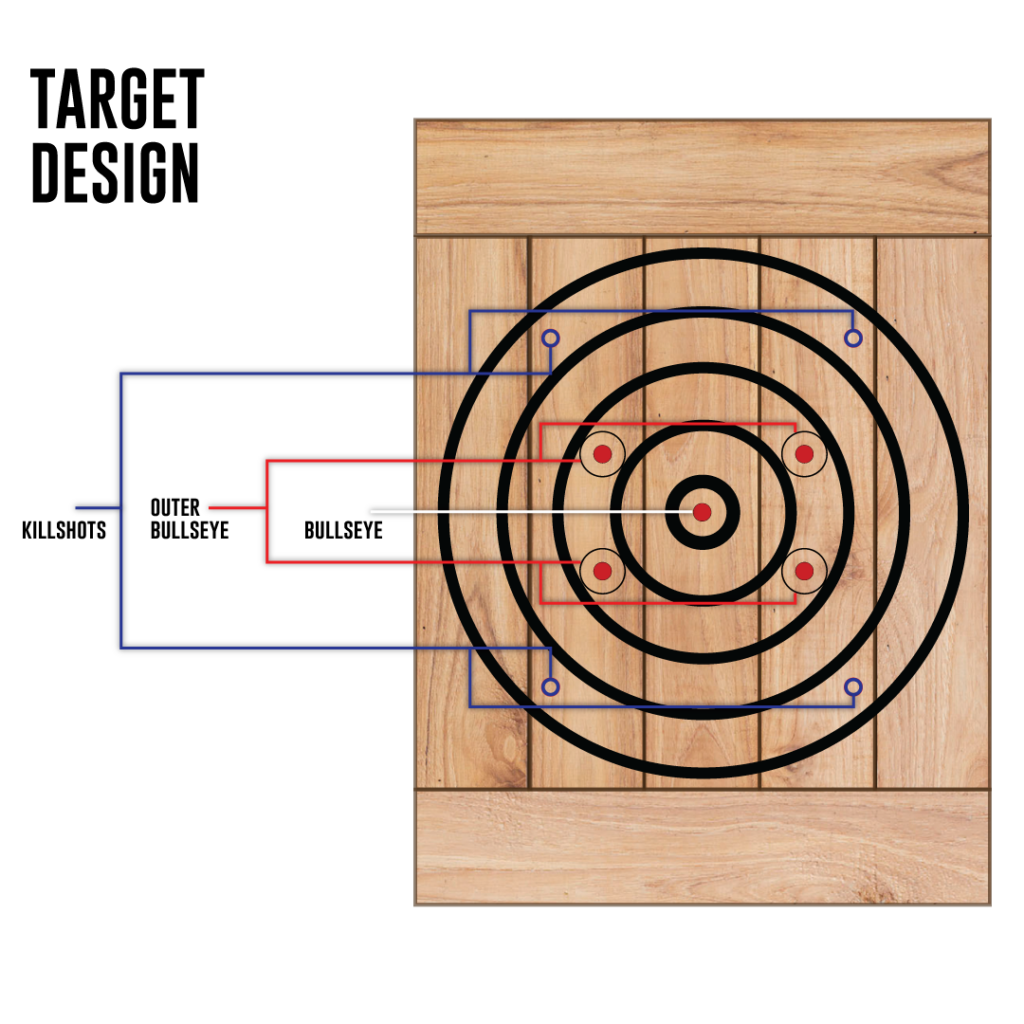
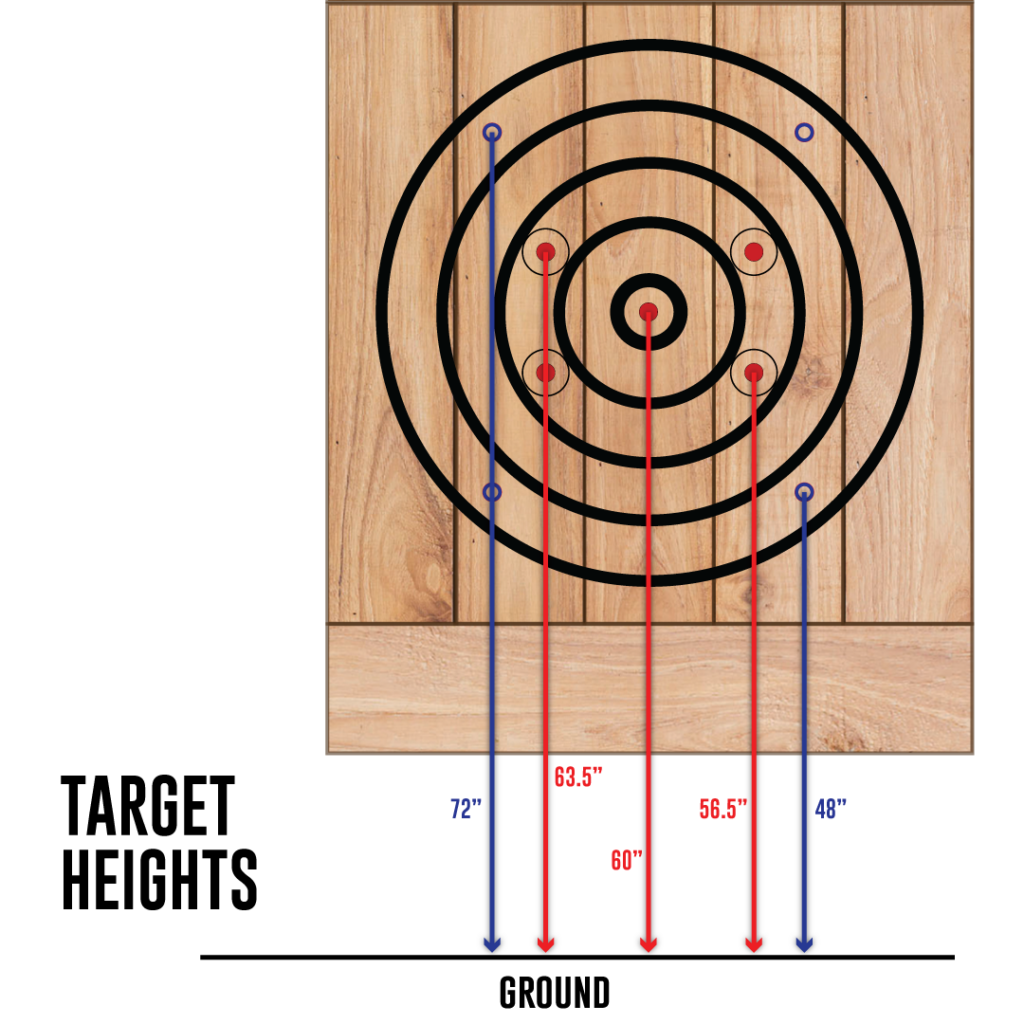
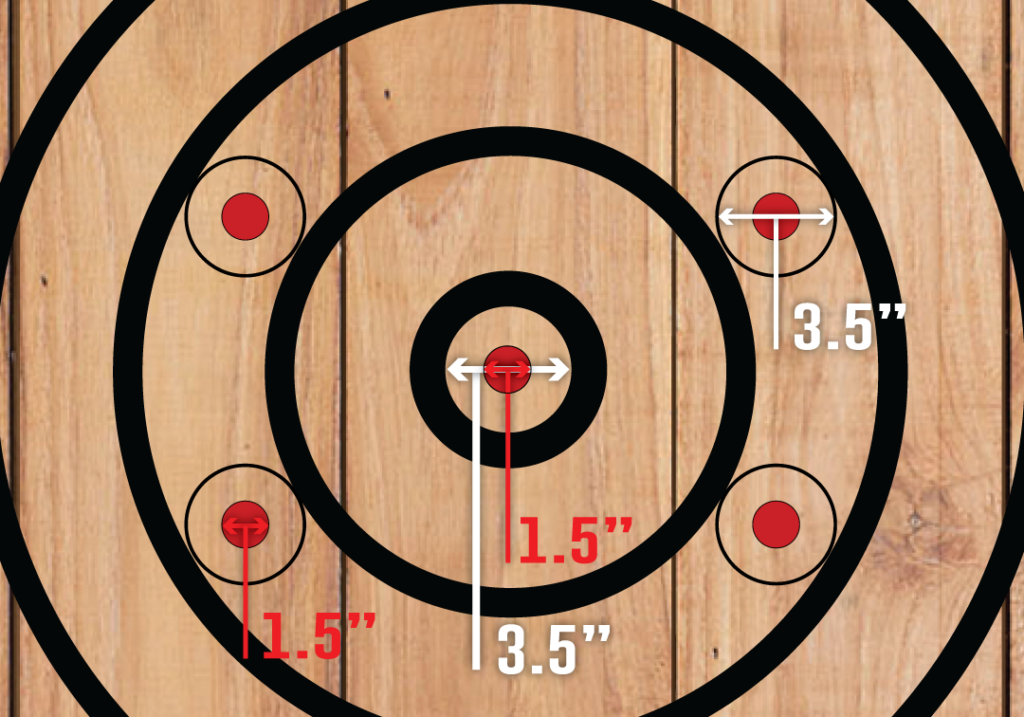
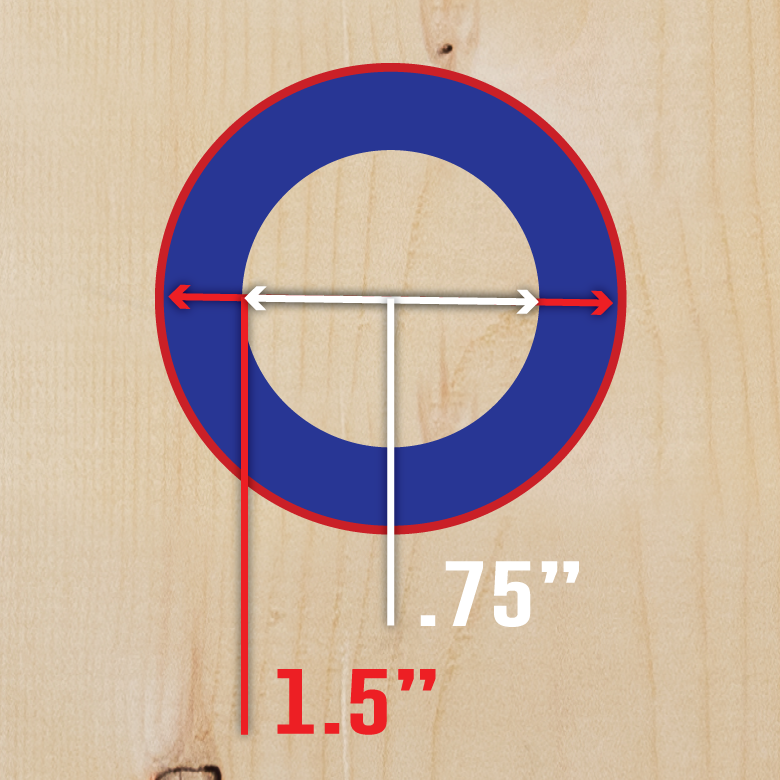
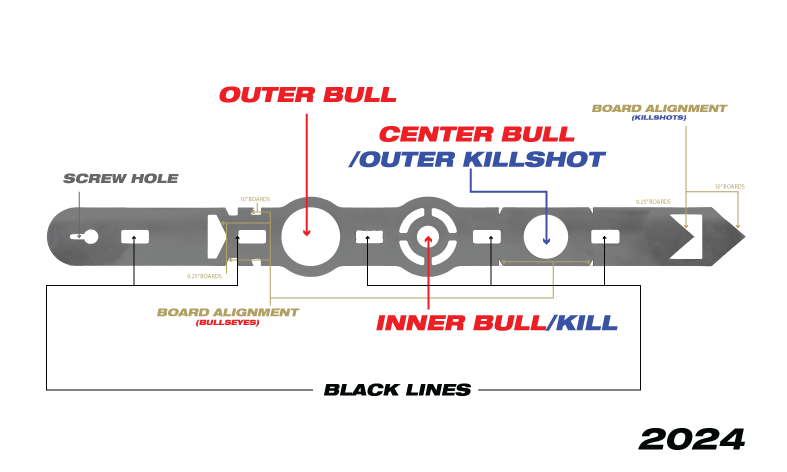
Drawing the 2025 Hatchet Target
WATL will not be releasing a new stencil for the 2025 Hatchet ruleset. The 2024 stencil may be used to easily determine the center of the 2025 outer bullseyes (within the 2024 outer 5 ring), followed by using a Perfect 6 stencil to outline the 5 rings and outer bullseyes.
Venue Target Specifications
So long as the targets for sanctioned league and tournament play follow the standards set forth in the section above, all following WATL target specifications are recommendations only.
Lanes
- Each throwing area is designated as a throwing lane.
- A regulation lane for competition must contain 2 targets.
- Fences or walls block this area from the rest of the facility to keep competitors and axes all contained in a safe environment.
- Only the two participating competitors and any Certified Judge are allowed inside the lane at one time. This includes ensuring the area behind the competitors is clear of any other person up to 5′.
- 12 ft minimum/clear ceiling height (within the throwing lane) is recommended for safety reasons.
- It is recommended for a lane to be a minimum of 12ft in width with the targets evenly distributed.
- It is recommended for a lane to be a minimum of 15ft in length to accommodate for a 12ft fault line and safe space to throw.
- For venues wishing to host Big Axe throwing, it is recommended for a lane to be a minimum of 20ft in length to accommodate for a 15ft fault line and safe space to throw.
- It is recommended that fault lines be 3 inches wide and that the fault be measured from the front of the target to the back of the line; if competitors step into/past the line, it is a fault.

Building a WATL Target
Each target should be made of 3 layers of wood.
- The first layer should cover the wall in OSB or plywood.
- The second layer is called the Backboards and should be made of wood.
- There should be roughly 7 horizontal 2×10 boards, that are 4′ feet long, drilled into the wall and packed tightly together to cover the full space for the target boards. This will be the backboard which will serve as a base to affix target boards.
- The third and outermost layer is comprised of target boards. These are also made of 4′ feet long 2×10 lumber. The targets consist of two components: 1) the target boards 2) the headers and footers.
- End Grain wood is permitted for WATL® targets
- Approximate Measurements for the 2×10 boards:
- U.S: Thickness: 1 ½ in • Width 9 ¼in • Length 4ft
- Metric: Thickness 38mm • Width 235mm Length 1.22m
- A variance of these measurements is allowed. WATL® does not enforce the exact thickness or width of boards, rather, the proper and accurate size of target specifications.
- They should be arranged just like the example picture below, with #WATL on the header or footer board.
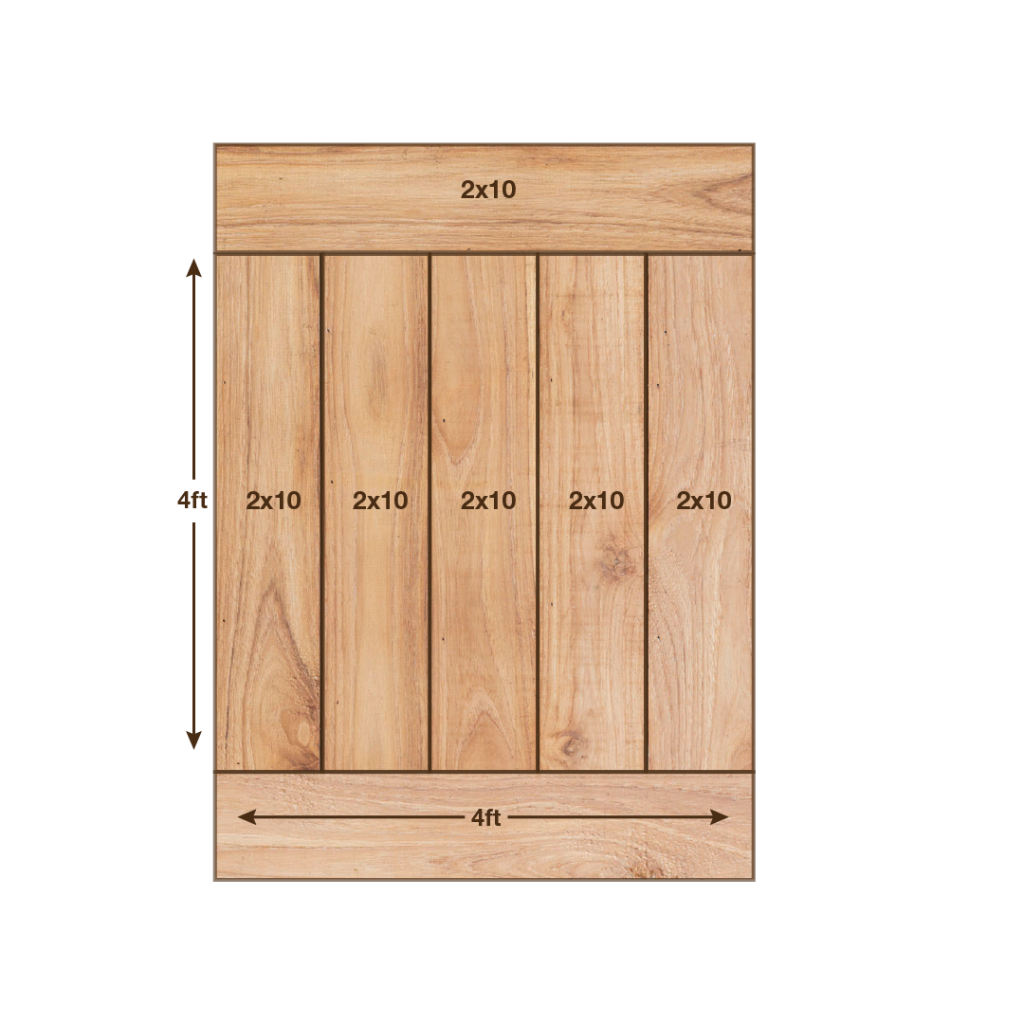
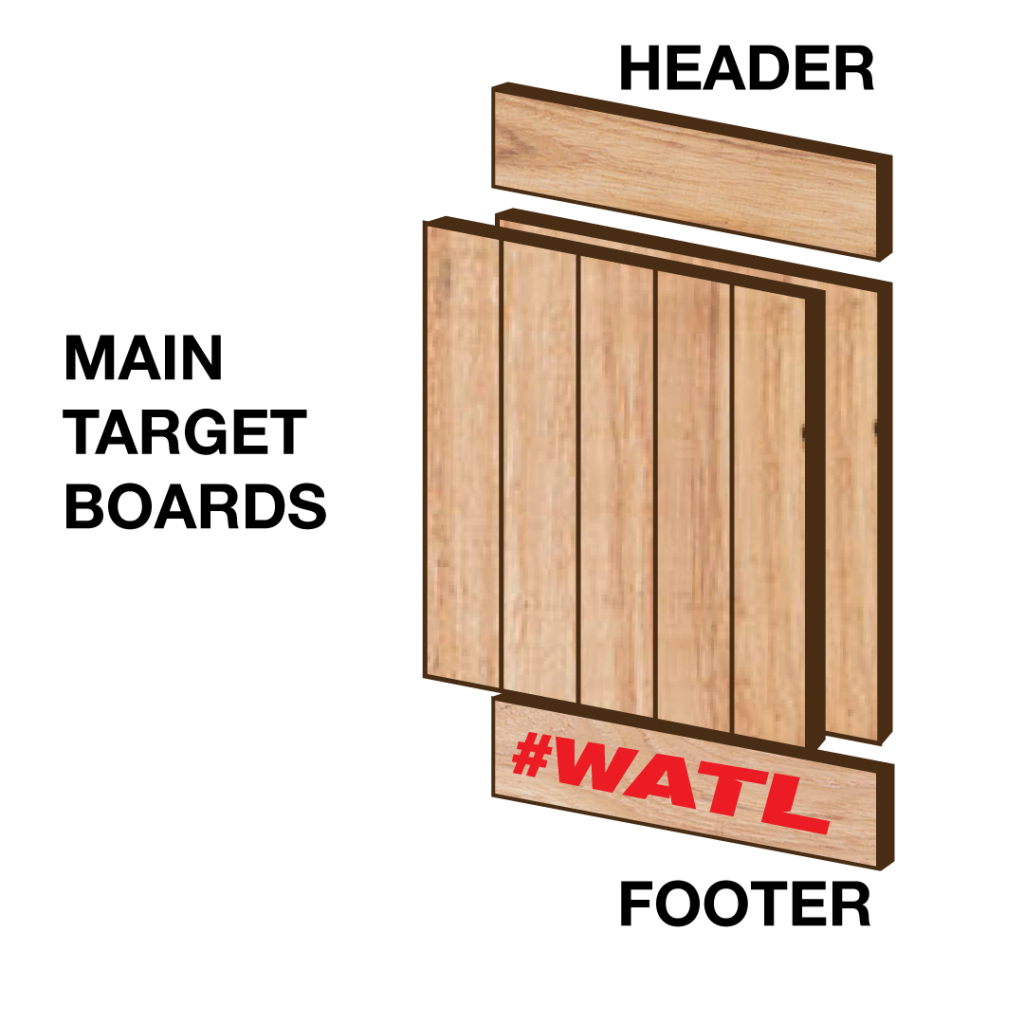
Section B: Hatchet Discipline Gameplay
The rules outlined below reflect the rules and regulations of the Hatchet discipline. These rules vary slightly in their application for different divisions of Hatchet gameplay (outlined in Section C), as well as the Hatchet Duals and Big Axe disciplines (outlined in Section D).
1. Targets
- Targets should be of sound quality before gameplay starts.
- Target boards should be changed, flipped or repaired at the discretion of the Lane Judge should they determine one of the following criteria are met.
- Excessive movement or ‘wiggling’ of the axe occurs when it lands in the damaged area causing or risking good throws to fall out.
- Scoring zones have significant gaps or are missing lines that would prevent scoring axes in those areas correctly.
- There is an apparent safety hazard posed by the arrangement or condition of the target boards.
- If a competitor disagrees with a Lane Judge’s call to not change, flip or repair the boards, they may request the Head Judge inspect the target(s). The Head Judge will then make the final decision.
- If targets become unscorable during the course of the match, the Lane Judge, at their discretion, may opt to move the match to another lane. If no lane is available, boards on the current lane may be swapped out before continuing play.
- If boards are changed during the course of a game, competitors may each take 1 practice throw at the new target.
- Boards must all be individually secured and not able to move during sanctioned gameplay.
- Competitors may not alter targets in any way that could be construed as intending to gain a scoring advantage.
- Examples may include tapping in a loose piece of the board, “chopping” a board to soften it, etc.
- Competitors may tap in a loose piece of the board with the judge’s permission.
- Spraying down the boards before or after a match is not considered altering the target.
- A competitor altering a target in any way will result in a 0 scored on that competitor’s next throw.
- Examples may include tapping in a loose piece of the board, “chopping” a board to soften it, etc.
2. Warm-up Throws
- The minimum number of warm-up throws at any sanctioned WATL® league or tournament is:
- 3 throws before a competitor’s first game of the day
- If no pre-tournament practice time is provided, the suggested number of practice throws prior to a competitor’s first game of the day is 10.
- 1 throw before each competitor’s subsequent game after their first game of the day..
- 3 throws before a competitor’s first game of the day
- The Head Judge or hosting venue, at their sole discretion, may determine a different number of warm-up throws.
- Warm-up times must be equally available to all competitors.
3. Safety and Faults
- If an axe breaks during a match in a manner that would make it unsafe to throw or causes it to be out of specifications, the Lane Judge may require the competitor to switch axes.
- If a Lane Judge has initiated a change requirement, there will be an automatic pause while the competitor retrieves their replacement axe.
- A competitor may also elect to change axes at any time. If the competitor has initiated the change, a 1-minute pause in play will be granted to retrieve the new axe.
- If an injury occurs, resulting in a pause in play, a competitor must be assessed by a Lane Judge or onsite medical professional.
- If the competitor is assessed and able to continue, then the paused game may continue.
- If a competitor is deemed unable to continue or wishes not to continue, the match will be awarded to the opponent.
- Throwing
- Competitors must remain behind their designated fault line until all scores have been indicated by the Lane Judge.
- The fault line is at 12′ for the Hatchet and Hatchet Duals disciplines
- The fault line is at 15′ for the Big Axe discipline
- If a competitor touches any part of the lane, equipment, or building past the designated fault line once the lane is active and before all scores for the current throw are called by the Lane Judge, that throw will be marked as a fault.
- A fault may be dismissed at the Lane Judge’s discretion for incidents that occur after all competitors in that lane have thrown and their axes have come to rest.
- Those throwing in wheelchairs must keep one wheel behind the designated fault line but are otherwise allowed past that line.
- Those requiring the assistance of a cane or other walking device may have that device resting past the fault line provided both feet remain behind the designated line.
- No equipment that emits sound or provides active noise cancellation (ANC), such as headphones or ANC earplugs/earbuds, may be used while throwing.
- Exceptions will be made for medical devices that aid in hearing.
- Competitors are required to inform the lane judge that they are wearing earplugs and/or a hearing device, and may need additional accommodations such as showing the score on the tablet between throws.
- Axes shall never be thrown when anyone is past the fault line in the lane.
- If a competitor does so, or throws in any other unsafe manner, the Lane Judge may remove that competitor from competition at which point they will be disqualified for the rest of the event.
- Spectators should maintain a safe distance from all competitors.
- Any overhead throw must be done with the blade facing away from the competitor.
- Competitors must remain behind their designated fault line until all scores have been indicated by the Lane Judge.
4. Playing a Game
- Each game consists of 10 throws.
- After 5 throws (one half), competitors will switch targets.
- Starting targets will be determined by the side assigned in the App when the game is selected.
- After 5 throws (one half), competitors will switch targets.
- Sudden Death – If the game is tied after 10 throws, players take additional throws exclusively at Killshots until a winner is determined.
- Any attempt that doesn’t touch a Killshot is considered a miss.
- The first attempt can target any Killshot, but each subsequent throw must target the next Killshot, clockwise.
- The first player to score higher than their opponent wins, and ends Sudden Death.
- Starting on the third sudden death killshot attempt, and on any subsequent attempt during sudden death that is a double miss, the Lane Judge will measure the distance from each axe’s closest scoring area to their respective scoring zones.
- Axes that drop or stick outside the target boards (such as in the header or footer) are considered unmeasurable and are not considered when measuring for the shortest distance.
- If the measurements are tied or both axes are unmeasurable, competitors will throw again, rotating Killshots clockwise.
- The thrower with the shortest measurable distance will be awarded the game.
- Pauses and Delays
- The lane is considered open for the next active throw when all competitors and the Lane Judge have returned behind the fault line, and no pause in play has been called by the Lane Judge.
- If a stalemate (neither competitor is willing to throw first) is caused by competitors waiting on their opponent to throw or call, then the competitor in the lead may have the advantage of waiting, and the Lane Judge will ask the trailing competitor to throw.
- Once prompted by the Lane Judge, the trailing competitor will have 10 seconds to complete their throw, after which time, the throw will count as a fault.
- If the game is tied, the Lane Judge will flip a coin to determine the first competitor.
- Throws must be taken within 10 seconds of each other, and any throw taken more than 10 seconds after an opponent’s throw will count as a fault.
- In order to count the throw as a fault, a timer must be used by the lane judge.
- A Lane Judge should institute a timer if they believe a competitor’s throwing pace suggests they might exceed the allotted time based on their current or previous performance.
- The judge must institute a timer should either competitor request it be instituted.
- If a timer is instituted, the Lane Judge must inform the competitors, and it must be used for a minimum of 3 throws or the remainder of the game.
- The lane judge may call a pause in play for any reason deemed necessary.
- Competitors may also request a pause in play that may be granted at the discretion of the Lane Judge.
- If a pause in play is called, the Lane Judge will indicate when the lane is open to throw, and play will commence from the point at which the pause was called.
- Challenges
- A competitor may challenge any score called by the Lane Judge if they believe it to be inaccurate.
- If a challenge is called, both competitors must return behind their designated fault lines until the final call is made.
- If a competitor alters the position of an axe in any way after a challenge is called, the lower value will automatically be applied to the axe in question.
- The final call is always made by the Head Judge (or by another Certified Judge selected by the Head Judge in the case the Head Judge is unavailable or has a conflict).
- The final call is final and binding for the remainder of the match and may not be disputed further.
- The Lane Judge must always make a call on each throw.
- If a competitor believes an incorrect application of the rules is being assessed, they may appeal to the Head Judge to investigate the matter.
- Upon review of the rules, if the competitor believes the Head Judge is also not properly applying the rules, they may appeal to the WATL Head Judge, the Head of Officiating, or any designated WATL rules expert.
- Upon review of the rules, if the competitor believes the Head Judge is also not properly applying the rules, they may file an appeal to the WATL® Head Judge, the Head of Officiating, or any designated WATL® rules expert. The appeal must include the specific rule in question, a detailed description of the incident, and any supporting evidence (video, photographs, witness statements, or other)
- Competitors may not retroactively issue challenges to completed matches.
- Any challenge automatically pauses the relevant game.
- It is the competitor’s responsibility to know and understand the rules and call seconds and challenges when applicable.
- Challenges/seconds can not be made by spectators unless they are made by a minor’s representative.
- Competitors under the age of 18 may name a representative to act on their behalf. The representative is only able to challenge calls on behalf of the competitor. Each representative is to be named before the start of the sanctioned event and communicated to Certified Judges. The representative is expected to follow all rules of play as if they were the competitor.
- Challenges/seconds can not be made by spectators unless they are made by a minor’s representative.
- A competitor may challenge any score called by the Lane Judge if they believe it to be inaccurate.
5. Scoring
All scoring is based on touch scoring where the valid scoring area of an axe makes contact with the surface of the board. Axes only need to make contact with the scoring area on one side of the blade; scoring area is not required on both sides of the axe blade.

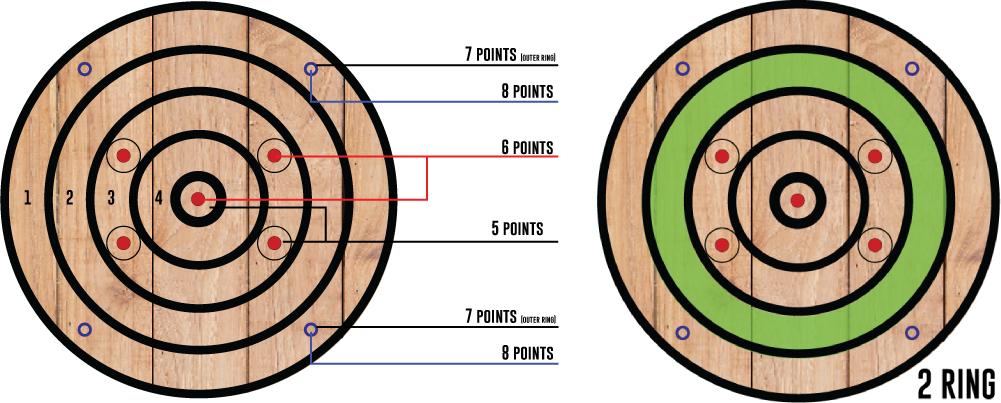
- Scoring Area of the Axe
- The valid scoring area of the axe includes the bit up to the front of the eye but not past it.
- If there is no visible eye, the valid scoring area is determined by where the front of the handle meets the axe head.
- Axes that contain more than one bit embedded in the target will score based on the valid, intended scoring area of the axe.
- An axe is scored based on the highest valid scoring zone that touches the valid scoring area of the axe.
- Any part of the axe embedded below the scoring surface does not count for scoring.
- Axes cannot be moved to determine score and must be scored as they lie.
- Wood significantly shifted away from the intended scoring zone does not count for scoring.
- If an axe falls to the ground before the Lane Judge scores the axe, that axe is counted as a drop.
- The valid scoring area of the axe includes the bit up to the front of the eye but not past it.
- Scoring Zones
- There are 5 black rings that outline the scoring zones of the target.
- Target ring scoring zones are based on the space between black rings. Reference the scoring zone above, labelled “2 ring”, to better visualize the scoring zone of a 2 ring.
- Black marker rings are considered part of the scoring area of the lower of the two values they separate.
- Sticking in the target outside the outermost ring scores 0 points.
- There are 5 black rings that outline the scoring zones of the target.
- Bullseyes
- There are 5 bullseyes on the board worth 6 points, each centered within a 5 ring.
- 4 of these bullseyes are within the 3 ring, and one is in the center of the target.
- All 6s and the outer 5s are outlined with a ballpoint pen which counts as part of the scoring zone for that target.
- There are 5 bullseyes on the board worth 6 points, each centered within a 5 ring.
- Killshots
- There are 4 ‘Killshots’ located within the 1 point ring of the target that consist of an ‘inner’ and ‘outer’ scoring zone.
- A Killshot is considered a hit if it touches any part of the Killshot (inner or outer) and does not drop prior to scoring.
- Hitting an inner Killshot is worth 8 points, and hitting an outer Killshot is worth 7 points.
- All inner and outer Killshots are outlined with a ballpoint pen which counts as part of the scoring zone for that target.
- The pen line counts as part of the valid scoring zone for both the inner and the outer Killshots.
- Killshots must be ‘called’ in order to count for points.
- To call a Killshot, a competitor must indicate to the Lane Judge that they intend to throw for Killshot.
- Once a Killshot is called and confirmed by the Lane Judge, the decision may not be changed.
- Killshots may not be called once either competitor has thrown.
- If a Killshot is called, failing to hit any part of a valid Killshot is worth 0 points.
- Only 2 Killshots may be called during the match.
- In the event of a drop on any throw (except the tenth), the competitor who scored a drop is awarded one additional Killshot.
- Each subsequent drop will award an additional Killshot for that competitor.
- To call a Killshot, a competitor must indicate to the Lane Judge that they intend to throw for Killshot.
- There are 4 ‘Killshots’ located within the 1 point ring of the target that consist of an ‘inner’ and ‘outer’ scoring zone.
- Closing Point Values
- Scoring points on a Killshot attempt closes both Killshots at that height.
- Killshots do not reset at the half.
- Hitting a second Killshot at the same height will count as a miss.
- If a competitor has been awarded an additional Killshot due to a dropped axe, their next attempt must be at the opposite height as their most recently scored Killshot
- Scoring points on a Killshot attempt closes both Killshots at that height.
Section C: Hatchet Divisions
The guidelines outlined below reflect divisional parameters and regulations of the Hatchet discipline only. The Hatchet Duals and Big Axe disciplines will not be subject to divisional play.
- Recreational Division Ruleset
- The Rec ruleset is the base game as highlighted in the sections above.
- Am Division Ruleset
- The Amateur, or Am division is the intermediate level for competitors of the World Axe Throwing League.
- Gameplay Changes
- Closing Point Values
- Each unique Bullseye and 5 ring close out once scored in a half.
- If an axe is embedded in the target where there are two open same-value closeable scoring zones in contact with the axe’s scoring area, the competitor can choose which closeable scoring zone counts for that throw, and closes out.
- Any closed point values (aside from Killshots) once hit a second time in a half will score according to the ring’s value that the closed point value resides in. For example:
- Hitting a closed 6 while the 5 value is open, results in a 5.
- Hitting a closed center 5 while the center 5 value is closed, results in a 4.
- Hitting a closed outer 5 will result in a 3.
- Should the scoring area of the axe be in two valid closeable scoring zones where one is already closed, the value defaults to the open scoring zone.
- All non-Killshot values open when opponents switch sides.
- Closing Point Values
- Pro Division Ruleset
- The Professional, or Pro division is the expert level for competitors of the World Axe Throwing League.
- Gameplay Changes
- Closing Point Values
- Hitting any scoring zone within a 5 ring closes all scoring zones within that ring for the remainder of the half. Hitting inside the same 5 ring a second time in a half will result in a score of 0.
- If an axe is embedded in the target where there are two open same-value closeable scoring zones in contact with the axe’s scoring area, the competitor can choose which closeable scoring zone counts for that throw, and closes out.
- Should the scoring area of the axe be in two valid closeable scoring zones where one is already closed, the value defaults to the open scoring zone.
- All non-Killshot values open when opponents switch sides.
- Closing Point Values
- Gameplay Changes
- The Professional, or Pro division is the expert level for competitors of the World Axe Throwing League.
- Division Changes
- Competitors can submit a request to move to any division between seasons and WATL® will review requests on a case-by-case basis.
- Any competitor who accepts a bid to the World Axe Throwing Championship will automatically be declared as Pro for the following season.
- Competitors cannot change their division during an active season for any reason.
- Should a division change from Am to Pro, or Pro to Am be approved, all Circuit Points, bids, invites, or entries that were related to the original division of that discipline are forfeited immediately. Should the competitor switch back to their previous designation in the future, those points/bids/etc will not be reinstated.
To request a division change, fill out this form.
Section D: Big Axe & Hatchet Duals Disciplines
The Big Axe and Hatchet Duals disciplines follow all rules outlined in sections A & B with the following exceptions. Hatchet Duals and Big Axe games may be played on the standard hatchet target; however, the bullseyes and 5 rings located within the 3-point ring of the target are not active for scoring purposes.
1. Big Axe
- Axe Specifications (replaces Section A 1.i)
- The total axe weight must be at least 3lbs, but no more than 4.25lbs
- The handle length must be a minimum of 23in to a maximum of 30in as measured from the lowest point of the handle to the highest point of the eye on top of the axe head.
- The axe blade cannot be more than 4 ⅝in
- Gameplay Changes
- A big axe game consists of 7 throws.
- Competitors will switch sides after each game but will remain on the same target for the duration of each game.
- The fault line is moved to 15ft for all 7 throws.
- Target Differences
- 5s and bullseyes can only be scored on the center board of the target.
- Killshots
- A Killshot is considered a hit (worth 8 points) if it touches any part of the Killshot (inner or outer) and does not drop prior to scoring.
- An extra Killshot attempt is not awarded for a drop.
- Closing point values
- Only hit Killshots close; there is no requirement to alternate heights until sudden death.
2. Hatchet Duals
The Hatchet Duals discipline involved two teammates throwing at the same target simultaneously. Both axes count towards a total team score for the game.
- Gameplay Changes
- A Hatchet Duals game consists of 5 throws, and teams will throw all 5 throws at the same target.
- A ‘throw’ consists of 2 axes thrown simultaneously by the same team.
- A fault for either competitor on a team results in a fault for the entire throw, and both axes will be scored as faults.
- If one competitor’s axe hits the target before their teammate has let go of their axe, that throw will count as a fault.
- Teams will switch sides after each game but will remain on the same target for the duration of each game.
- As a safety precaution, competitors must throw from approximately the same distance. (One competitor cannot release their axe at the 12ft line and another at the 15ft line).
- For an axe that is only embedded into another axe, both axes will receive the point value of the axe embedded in the target.
- In order for an embedded axe to count as a hit Killshot, both competitors must have called for a Killshot attempt.
- In the event only one competitor has called a Killshot on the relevant throw, the other axe will score based on the location of the axe in the board.
- Once an axe is scored, the Lane Judge may ask the competitor to remove their scored axe to determine the score of their teammate’s axe. If removing the first axe causes the second axe to drop, the lower score threshold will be given.
- A Hatchet Duals game consists of 5 throws, and teams will throw all 5 throws at the same target.
- Target Differences
- 5s and bullseyes can only be scored on the center board of the target.
- Killshots
- A Killshot is considered a hit (worth 8 points) if it touches any part of the Killshot (inner or outer) and does not drop prior to scoring.
- An extra Killshot attempt is not awarded for a drop.
- Each team is allowed to call 2 Killshots per game. (These can be taken separately or on the same throw).
- Killshots only close after both axes are scored, and two axes touching the same Killshot scores 16 points (provided both competitors have called a Killshot).
- Closing point values
- Only hit Killshots close; there is no requirement to alternate heights until sudden death.
- Sudden Death
- All competitors must still individually rotate Killshot attempts in a clockwise pattern.
- The first team to score more Killshots in a single attempt than their opponent wins, and ends Sudden Death.
- Starting on the third sudden death killshot attempt, and on any subsequent attempt during sudden death that is a double miss, the Lane Judge will measure the distance from each axe’s closest scoring area to their respective scoring zones.
- Axes that drop or stick outside the target boards (such as in the header or footer) are considered unmeasurable and are not considered when measuring for the shortest distance.
- If the measurements are tied or both axes are unmeasurable, competitors will throw again, rotating Killshots clockwise.
- The team with the single shortest measurable distance will be awarded the game.
Click below to view the 2025 Gameplay Rules. Please note, the 2025 ruleset is no longer active or valid as of 12/31/25 with the exception of the World Axe Throwing Championship in April 2026.
Glossary
1 Ring: the outermost target ring with a scoring zone that awards 1 point once hit, that also hosts the 4 Killshots
2 Ring: the second outermost target ring, with a scoring zone that awards 2 points once hit
3 Ring: the middle target ring with a scoring zone that awards 3 points once hit, that also hosts the outer 5 rings and bullseyes
4 Ring: the second innermost target ring with a scoring zone that awards 4 points once hit
Big Axe: an axe with minimum weight of 3lbs and a minimum length of 23in
Big Axe Discipline: a discipline using a Big Axe, from a fault line of 15ft
Bit: the sharpened edge of an axe blade, used to stick in the board
Black Ring: circular lines that outline the scoring zones of the target
Bullseye: a red circle on the target worth 6 points
Center 5 Ring: the innermost target ring with a scoring zone that awards 5 points once hit, that also hosts the center bullseye
Certified Judge: An individual who has attained the official WATL Judge Certification to officiate sanctioned leagues and tournaments, ensuring adherence to rules and proper scoring.
Cheek: The flat side of an axe head, located between the bit and the poll.
Circuit Points: points earned by competitors in sanctioned WATL events
Discipline: a specific set of rules and the gameplay format including approved equipment that can be hosted at official sanctioned WATL leagues and tournaments.
Drop: when an axe is thrown but does not stick to the target surface in any scorable or non-scorable area, resulting in a zero scored
Double Miss: when all competitors in a game fail to hit a scorable killshot in sudden death
Eye: the hole in the center of an axe head where the handle is inserted and secured
Fault Line: the line that competitors must not step over when throwing, resulting in a zero scored for the throw
Game: a single-scored set of throws between 1 or more competitors which can vary between 5, 7 or 10 throws depending on the discipline
Ghost Game: a single competitor completing a game without an opponent
Hatchet Duals: a discipline where two players compete as a team, throwing hatchets simultaneously at the same target
Hatchet: a smaller axe with maximum weight of 3lbs and a maximum length of 19in
Hatchet Am Division: a competitive tier for experienced competitors with moderate skill levels
Hatchet Pro Division: a competitive tier for competitors at the highest skill level
Hatchet Rec Division: a non-competitive tier for beginner or casual competitors
Head Judge: an official responsible for overseeing other Certified Judges as well as the rules, scoring, and overall conduct of a league or tournament
Heel: the bottom end of an axe bit, opposite the toe
Hit: a successful impact of an axe’s scoring area to the target’s scoring zone
Inner Killshot: a small blue circle located inside an outer Killshot on a target
Killshot: the blue circles in the upper and lower corners of the target inside the 1 ring, worth 7 or 8 points when called and successfully hit
Killshot Attempt: a throw where the competitor “calls” the Killshot before throwing, aiming specifically for one of the four Killshots
Lane: the designated area consisting of one or more fault lines and two targets
Lane Judge: an individual Certified to score Sanctioned games, responsible for overseeing the conduct and scoring of players within a specific lane during a league or tournament
Lower Bullseye: the two outer bullseyes that are located lowest on the board
Lower Killshot: the two Killshots that are located lowest on the board
Match: a set of 2 to 3 games, where the competitor who wins 2 games is declared the winner
Outer Killshot: the target ring surrounding the inner killshot on a target, located at the top and bottom of the 1 ring
Poll: the rear end of an axe head, also known as the butt, which is opposite the bit
Scoring Area: the portion of the axe from the bit to to the front of the eye that must touch a scoring zone to attain points
Scoring Zone: the area on a target where points are awarded based on the location of the scoring area of an axe’s impact
Stick: a throw where the axe embeds in the target, indicating a valid scoring attempt
Target Ring: a section on the target that contains scoring zones for 1-5 points
Toe: the top end of an axe bit, opposite the heel
Upper Bullseye: the two outer bullseyes that are located highest on the board
Upper Killshot: the two Killshots that are located highest on the board
Still have a rules question?
Send us a message and we'll answer it ASAP!
Get Exclusive Offers & Stay Up-To-Date
Sign-up today and never miss an update in the exciting world of axe throwing.

